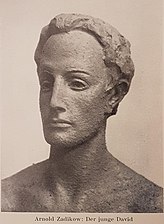Arnold Zadikow's Human Design Chart
4/6 Sacral Generator**Arnold Zadikow: A Human Design Perspective**
Arnold Zadikow was a renowned German-Jewish modernist sculptor and medallist, celebrated for his impactful works in Germany and France. Born on March 27, 1884, in Kolberg, Germany, Zadikow’s creative journey was deeply influenced by his Human Design as a Generator. This type is characterized by a powerful sacral response, which guided him to respond to the world around him through his art. His strategy of “To Respond” allowed him to create meaningful sculptures that resonated with both personal and collective experiences.
Zadikow studied under the neoclassical sculptor Heinrich Waderé, honing his skills primarily in portrait busts, gravestones, and plaques. His work often incorporated biblical motifs, reflecting his deep connection to his heritage. Notably, his sculpture of the young David was displayed at the entrance of the Berlin Jewish Museum in 1933, a piece he considered his most important work. Tragically, this statue was lost during the destruction wrought by the Nazis in World War II.
As a 4/6 Profile in Human Design, Zadikow embodied the duality of being both a “Personal Role Model” and a “Role Model for Others.” This aspect of his profile is evident in his ability to inspire fellow artists and engage with the broader community, especially during a tumultuous time in history. His Incarnation Cross, the Right Angle Cross of Service (17/18 | 58/52), further emphasizes his commitment to serving others through his artistic contributions. The channels in his design, including 17-62, 18-58, and 3-60, highlight his capacity for deep insight and transformation, enabling him to navigate the complexities of his environment and create art that spoke to the human experience.
Zadikow’s life took a dramatic turn during World War I when he served as a soldier on the Western Front, sustaining injuries in 1917 before being captured and taken to a British prisoner of war camp. After the war, he settled mainly in Munich and Rome, with a brief period in Paris in 1932. In 1933, sensing the impending danger for Germany’s Jewish population, he moved to Prague with his wife Hilda and their daughter Marianka, where he was joined by fellow artists like Oskar Kokoschka and John Heartfield.
The Nazi invasion of Czechoslovakia in 1939 marked a dark chapter in Zadikow’s life. On May 15, 1942, he and his family were rounded up and sent to the Theresienstadt concentration camp, where he tragically passed away on March 8, 1943, at the age of 58. Hilda and Marianka were later transported to Auschwitz-Birkenau but survived long enough to be liberated in 1945.
Throughout his artistic career, Zadikow designed decorative gravestones, including one for the pioneering sexologist Magnus Hirschfeld. His connection to influential figures extended to Albert Einstein, who commissioned him to create a headstone for a family member while he was in Paris.
Arnold Zadikow’s legacy as a sculptor is not only marked by his artistic achievements but also by the profound impact of his Human Design, which guided his responses to the world and his commitment to service through art. His story remains a testament to resilience and creativity in the face of adversity, reflecting the essence of a Generator who responded to life with purpose and passion.
Discover More Famous People
Browse and analyze over 55,000 public figures and celebrities.
Ra Uru Hu
5/1 Manifestor
Martha Stewart
4/6 Manifestor
David Lynch
4/6 Generator
Barack Obama
6/2 Projector
Steve Jobs
6/3 Generator
Vladimir Putin
5/1 Manifestor
Kim Kardashian
3/5 Generator
Michael Jackson
1/3 Projector
Marilyn Monroe
6/2 Projector
Ariana Grande
2/4 Projector
Oprah Winfrey
2/4 Generator
Johnny Depp
2/4 ManifestorWhat is HumanDesign.ai and how does it work?
Curious what makes Arnold Zadikow tick? HumanDesign.ai instantly maps their exact birth data into a fully interactive clickable bodygraph chart, letting you hover or tap every center, channel, and gate for plain-language explanations. Bella, the platform’s built-in AI guide, adds context in real time, translating complex mechanics into everyday insights so you can see how Arnold Zadikow’s strengths, challenges, and life themes play out on-screen.
The same tools are waiting for you. Generate your own Human Design Chart in seconds, open a library of 2000+ suggested questions, and chat with Bella as often as you like to decode your design, daily transits, and even relationship dynamics.
Want to compare energies? Save unlimited charts for friends, family, or clients, then ask Bella to reveal compatibilities, composite patterns, or coaching tips, all in one conversation thread.
Start free with core features, or unlock our Personal and Pro plans for deeper dives: unlimited Q&A, celebrity chart search spanning 55,000+ public figures, white-label PDF reports, branded content generation, and a professional profile with built-in booking for practitioners. Whether you’re exploring your own potential or guiding others, HumanDesign.ai delivers an ever-expanding toolbox of AI-powered insights—no spreadsheets, no jargon, just clarity at your fingertips.
Ready to see yours? Signup for FREE today!

